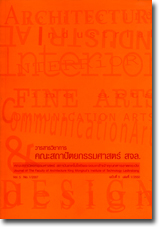การมีส่วนร่วมของชุมชนในการออกแบบที่อยู่อาศัย : ประสบการณ์จากชุมชนผู้มีรายได้น้อยริมคลองใน
Main Article Content
Abstract
บทคัดย่อ
บทความนี้มุ่งหมายที่จะสะท้อนกระบวนการทำงานเพื่อแก้ปัญหาที่อยู่อาศัยของชุมชนผู้มีรายได้น้อย และการมีส่วนร่วมของชุมชนรวมถึงบทบาทของสถาปนิกในการออกแบบที่อยู่อาศัยเพื่อชุมชน โดยอาศัยบทเรียนที่ได้รับจากประสบการณ์การทำงานร่วมกับคนในชุมชน โดยใช้กรณีศึกษาชุมชนผู้มีรายได้น้อยริมคลองใน กทม. 2 แห่งที่มีบริบทที่แตกต่างกัน เพื่อนำไปสู่แนวทางการปรับปรุงชุมชนที่แตกต่างกัน โดยชี้ให้เห็นความสำคัญของมิติอื่น ๆ ที่นอกเหนือจากมิติทางด้านกายภาพที่มีผลต่อการปรับปรุงชุมชนอย่างเป็นรูปธรรม โดยพบว่ากระบวนการเรียนรู้ร่วมกันของผู้มีส่วนเกี่ยวข้องทุกฝ่ายจะเป็นตัวจักรสำคัญในการ “สร้างชุมชน” (Community building) อย่างไรก็ตามในการออกแบบนั้น ประเด็นที่ผู้ออกแบบสถาปนิก จะต้องพิจารณาร่วมอย่างระมัดระวัง ได้แก่ ประเด็นด้านการเงิน สังคมวิทยา และการเมืองในชุมชน
คำสำคัญ : การออกแบบชุมชนผู้มีรายได้น้อย, การมีส่วนร่วม, กระบวนการเรียนรู้ทางสังคม, ความขัดแย้งในชุมชน
Abstract
This paper aims to illustrated the working and community participatory process as well as the role of architects and urban designers in urban poor housing design derived from author’s experience through some upgraded low-income housing projects in Bangkok. Two cases are comparatively similar and different context which finally direct to each particular housing development guideline. The paper argues that other dimensions apart from physical significantly influence substantive outcomes. The learning experience among different involved parties can become one of the effective tools to conduct strong sense of belonging as well as community building. There are several concerns in design, which architects and urban planners / designers should not neglect and for low-income community those are economic, political and sociological considerations.
Keywords : Low-income housing design, Community participation, Social learning, conflict resolution and mediation
Article Details
This work is licensed under a Creative Commons Attribution-NonCommercial-ShareAlike 4.0 International License.
Copyright Transfer Statement
The copyright of this article is transferred to Journal of The Faculty of Architecture King Mongkut's Institute of Technology Ladkrabang with effect if and when the article is accepted for publication. The copyright transfer covers the exclusive right to reproduce and distribute the article, including reprints, translations, photographic reproductions, electronic form (offline, online) or any other reproductions of similar nature.
The author warrants that this contribution is original and that he/she has full power to make this grant. The author signs for and accepts responsibility for releasing this material on behalf of any and all co-authors.


